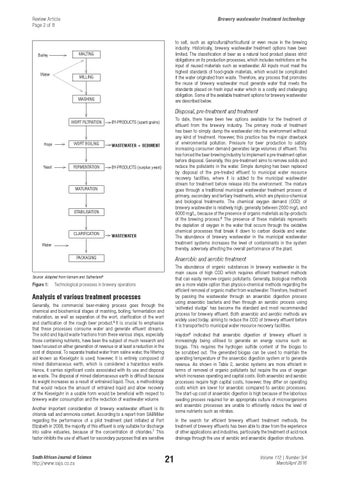Review Article Page 2 of 8
Brewery wastewater treatment technology
to salt, such as agricultural/horticultural or even reuse in the brewing industry. Historically, brewery wastewater treatment options have been limited. The classification of beer as a natural food product places strict obligations on its production processes, which includes restrictions on the input of reused materials such as wastewater. All inputs must meet the highest standards of food-grade materials, which would be complicated if the water originated from waste. Therefore, any process that promotes the reuse of brewery wastewater must generate water that meets the standards placed on fresh input water which is a costly and challenging obligation. Some of the available treatment options for brewery wastewater are described below.
MALTING
Barley
Water
MILLING
MASHING
Disposal, pre-treatment and treatment WORT FILTRATION
BY-PRODUCTS (spent grains)
Hops
WORT BOILING
WASTEWATER + SEDIMENT
Yeast
FERMENTATION
BY-PRODUCTS (surplus yeast)
To date, there have been few options available for the treatment of effluent from the brewery industry. The primary mode of treatment has been to simply dump the wastewater into the environment without any kind of treatment. However, this practice has the major drawback of environmental pollution. Pressure for beer production to satisfy increasing consumer demand generates large volumes of effluent. This has forced the beer brewing industry to implement a pre-treatment option before disposal. Generally, this pre-treatment aims to remove solids and reduce the pollutants in the water. Simple dumping has been replaced by disposal of the pre-treated effluent to municipal water resource recovery facilities, where it is added to the municipal wastewater stream for treatment before release into the environment. The mixture goes through a traditional municipal wastewater treatment process of primary, secondary and tertiary treatments, which are physico-chemical and biological treatments. The chemical oxygen demand (COD) of brewery wastewater is relatively high, generally between 2000 mg/L and 6000 mg/L, because of the presence of organic materials as by-products of the brewing process.8 The presence of these materials represents the depletion of oxygen in the water that occurs through the oxidative chemical processes that break it down to carbon dioxide and water. The abundance of brewery wastewater in the municipal wastewater treatment systems increases the level of contaminants in the system thereby, adversely affecting the overall performance of the plant.
MATURATION
STABILISATION
CLARIFICATION
WASTEWATER
Water PACKAGING
Anaerobic and aerobic treatment The abundance of organic substances in brewery wastewater is the main cause of high COD which requires efficient treatment methods that can easily remove organic pollutants. Generally, biological methods are a more viable option than physico-chemical methods regarding the efficient removal of organic matter from wastewater. Therefore, treatment by passing the wastewater through an anaerobic digestion process using anaerobic bacteria and then through an aerobic process using ‘activated sludge’ has become the standard and most recommended process for brewery effluent. Both anaerobic and aerobic methods are widely used today, aiming to reduce the COD of brewery effluent before it is transported to municipal water resource recovery facilities.
Source: Adapted from Varnam and Sutherland5
Figure 1:
Technological processes in brewery operations
Analysis of various treatment processes Generally, the commercial beer-making process goes through the chemical and biochemical stages of mashing, boiling, fermentation and maturation, as well as separation of the wort, clarification of the wort and clarification of the rough beer product.6 It is crucial to emphasise that these processes consume water and generate effluent streams. The solid and liquid waste fractions from these various steps, especially those containing nutrients, have been the subject of much research and have focused on either generation of revenue or at least a reduction in the cost of disposal. To separate treated water from saline water, the filtering aid known as Kieselguhr is used; however, it is entirely composed of mined diatomaceous earth, which is considered a hazardous waste. Hence, it carries significant costs associated with its use and disposal as waste. The disposal of mined diatomaceous earth is difficult because its weight increases as a result of entrained liquid. Thus, a methodology that would reduce the amount of entrained liquid and allow recovery of the Kieselguhr in a usable form would be beneficial with respect to brewery water consumption and the reduction of wastewater volume.
Haydon9 indicated that anaerobic digestion of brewery effluent is increasingly being utilised to generate an energy source such as biogas. This requires the hydrogen sulfide content of the biogas to be scrubbed out. The generated biogas can be used to maintain the operating temperature of the anaerobic digestion system or to generate revenue. As shown in Table 2, aerobic systems are more efficient in terms of removal of organic pollutants but require the use of oxygen which increases operating and capital costs. Both anaerobic and aerobic processes require high capital costs, however, they differ on operating costs which are lower for anaerobic compared to aerobic processes. The start-up cost of anaerobic digestion is high because of the laborious seeding process required for an appropriate culture of microorganisms and anaerobic processes are unable to efficiently reduce the level of some nutrients such as nitrates.
Another important consideration of brewery wastewater effluent is its chloride salt and ammonia content. According to a report from SABMiller regarding the performance of a pilot treatment plant initiated at Port Elizabeth in 2008, the majority of this effluent is only suitable for discharge into saline estuaries, because of the concentration of chlorides.7 This factor inhibits the use of effluent for secondary purposes that are sensitive
South African Journal of Science
http://www.sajs.co.za
In the search for efficient brewery effluent treatment methods, the treatment of brewery effluents has been able to draw from the experience of other applications and industries, particularly the treatment of acid rock drainage through the use of aerobic and anaerobic digestion structures.
21
Volume 112 | Number 3/4 March/April 2016
